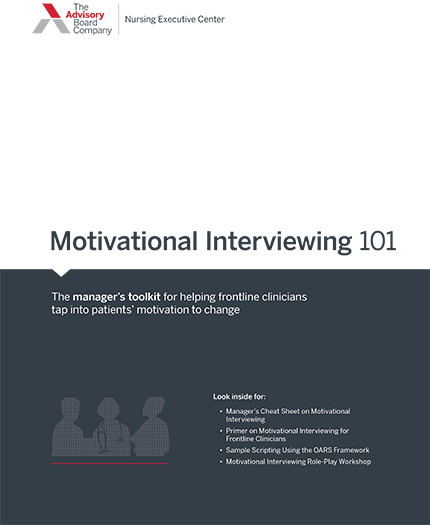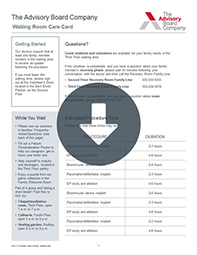Editor's note: This popular story from the Daily Briefing's archives was republished on Jan. 29, 2020.
The relationship between nurses and patients' families isn't always peaceful, but the right communication strategies can go a long way toward improving patient care, Laura Landro reports for the Wall Street Journal.
Minimize family anxiety with this customizable waiting room care card
Patients' families play an important role in advocating for their loved ones who are in the hospital. But nurses must walk a tightrope, remaining attentive to families' concerns while also asserting their expertise and staying on top of their busy schedules.
Still, experts say nurses and families can build healthy, productive relationships if they use the right communication strategies.
Building a connection
It helps to get off on the right foot. Kathleen Turner—a night-shift bedside nurse in the ICU at the University of California, San Francisco Medical Center (UCSF), who teaches workshops on patient communication—said she took the time to purchase candy for the nursing staff when she visited an ill family member in the hospital recently. She wanted to advocate for the best possible care—but she also worried about being a "pest." The candy, she thought, seemed like a good way to signal to the nurses on the unit that she knew what they were going through as well.
The larger theme, Turner said, is that nurses and families need to build a real connection. "When things don't go well between nurses and families, it's often a breakdown in communication," she explained.
Luckily, those communication skills can be taught. Turner recently published a study in the American Journal of Critical Care about UCSF critical-care nurses who attended one of her workshops. Compared with before the workshop, the percentage of nurses who said they had excellent or very good patient and family communication skills was higher three months after the workshop.
UCSF is now working with the not-for-profit VitalTalk to post similar workshops on the web so that health care professionals can strengthen their communication skills on their own time.
Patient and family advisory councils also can help providers understand families' perspectives. Jayne McCullough, an ICU nurse and co-coordinator of UCSF's council, said she frequently hears from families that they feel too intimated to speak up—which can put their loved ones at risk.
Families need to know it's OK to speak to a nurse about their concerns, even if they're worried about seeming pushy. "I would take being embarrassed or corrected any day over actually harming someone," McCullough said.
Nurses have unique expertise—but so do families
Still, nurses also need to know when to stand their ground, explained Karen Anderson, a clinical nurse specialist in patient- and family-centered care at the Hospital of the University of Pennsylvania. "When families get stressed, they sometimes go outside their role. They want to determine care or start trying to dictate things," she noted.
For instance, Anderson said nurses sometimes face demands from families to increase the dose of a painkiller. "You have to trust the doctor had reasons, or the nurse knows when to increase the dose," she said.
They key is finding a balance and understanding that patients and families have unique sets of expertise. "A nurse is an expert in vital signs," she said, "but you are the expert in your mom" (Landro, Wall Street Journal, 7/4).
Minimize family anxiety with this customizable waiting room care card
It’s tough to balance provider productivity and patient-centeredness, and the waiting room is one frequently overlooked opportunity to find equilibrium. By explaining what to expect during procedures, you can neutralize a major source of family anxiety and questions.
We've made it easy. Use our template to create a "waiting room care card" that addresses key family questions. Just drop in your logo and add your institution’s protocols. Save, print, and start improving your waiting room experience.
Don't miss out on the latest Advisory Board insights
Create your free account to access 1 resource, including the latest research and webinars.
Want access without creating an account?
You have 1 free members-only resource remaining this month.
1 free members-only resources remaining
1 free members-only resources remaining
You've reached your limit of free insights
Become a member to access all of Advisory Board's resources, events, and experts
Never miss out on the latest innovative health care content tailored to you.
Benefits include:
You've reached your limit of free insights
Become a member to access all of Advisory Board's resources, events, and experts
Never miss out on the latest innovative health care content tailored to you.
Benefits include:
This content is available through your Curated Research partnership with Advisory Board. Click on ‘view this resource’ to read the full piece
Email ask@advisory.com to learn more
Click on ‘Become a Member’ to learn about the benefits of a Full-Access partnership with Advisory Board
Never miss out on the latest innovative health care content tailored to you.
Benefits Include:
This is for members only. Learn more.
Click on ‘Become a Member’ to learn about the benefits of a Full-Access partnership with Advisory Board
Never miss out on the latest innovative health care content tailored to you.


